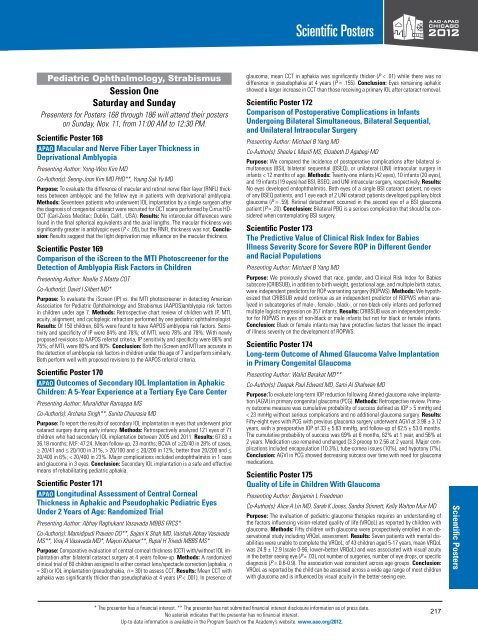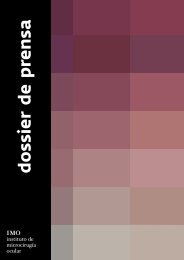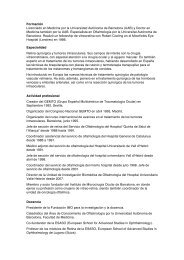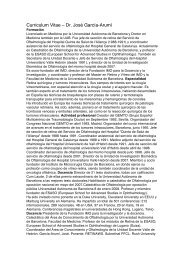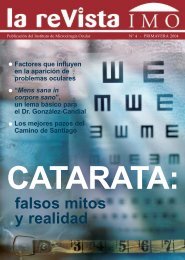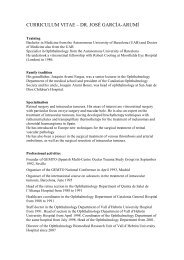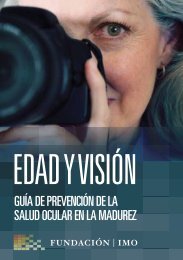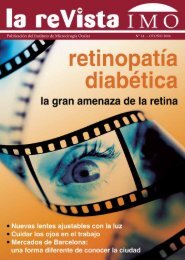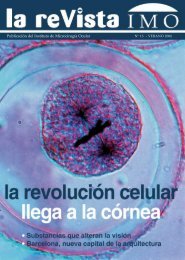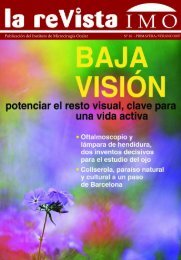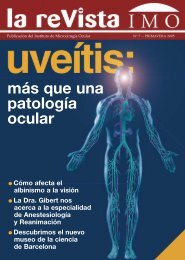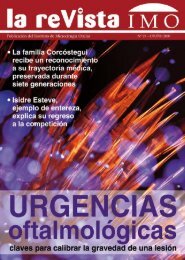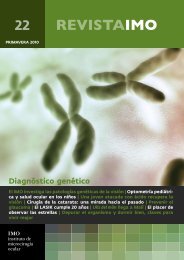FINAL PROGRAM - Imo
FINAL PROGRAM - Imo
FINAL PROGRAM - Imo
Create successful ePaper yourself
Turn your PDF publications into a flip-book with our unique Google optimized e-Paper software.
Scientific Posters<br />
Pediatric Ophthalmology, Strabismus<br />
Session One<br />
Saturday and Sunday<br />
Presenters for Posters 168 through 186 will attend their posters<br />
on Sunday, Nov. 11, from 11:00 AM to 12:30 PM.<br />
Scientific Poster 168<br />
APAO Macular and Nerve Fiber Layer Thickness in<br />
Deprivational Amblyopia<br />
Presenting Author: Yong-Woo Kim MD<br />
Co-Author(s): Seong-Joon Kim MD PHD**, Young Suk Yu MD<br />
Purpose: To evaluate the difference of macular and retinal nerve fiber layer (RNFL) thickness<br />
between amblyopic and the fellow eye in patients with deprivational amblyopia.<br />
Methods: Seventeen patients who underwent IOL implantation by a single surgeon after<br />
the diagnosis of congenital cataract were recruited for OCT scans performed by Cirrus HD-<br />
OCT (Carl-Zeiss Meditec; Dublin, Calif., USA). Results: No interocular differences were<br />
found in the final spherical equivalents and the axial lengths. The macular thickness was<br />
significantly greater in amblyopic eyes (P < .05), but the RNFL thickness was not. Conclusion:<br />
Results suggest that the light deprivation may influence on the macular thickness.<br />
Scientific Poster 169<br />
Comparison of the iScreen to the MTI Photoscreener for the<br />
Detection of Amblyopia Risk Factors in Children<br />
Presenting Author: Noelle S Matta COT<br />
Co-Author(s): David I Silbert MD*<br />
Purpose: To evaluate the iScreen (IP) vs. the MTI photoscreener in detecting American<br />
Association for Pediatric Ophthalmology and Strabismus (AAPOS)amblyopia risk factors<br />
in children under age 7. Methods: Retrospective chart review of children with IP, MTI,<br />
acuity, alignment, and cycloplegic refraction performed by one pediatric ophthalmologist.<br />
Results: Of 150 children, 60% were found to have AAPOS amblyopia risk factors. Sensitivity<br />
and specificity of IP were 84% and 78%; of MTI, were 78% and 78%. With newly<br />
proposed revisions to AAPOS referral criteria, IP sensitivity and specificity were 86% and<br />
75%; of MTI, were 80% and 80%. Conclusion: Both the iScreen and MTI are accurate in<br />
the detection of amblyopia risk factors in children under the age of 7 and perform similarly.<br />
Both perform well with proposed revisions to the AAPOS referral criteria.<br />
Scientific Poster 170<br />
APAO Outcomes of Secondary IOL Implantation in Aphakic<br />
Children: A 5-Year Experience at a Tertiary Eye Care Center<br />
Presenting Author: Muralidhar Ramappa MS<br />
Co-Author(s): Archana Singh**, Sunita Chaurasia MD<br />
Purpose: To report the results of secondary IOL implantation in eyes that underwent prior<br />
cataract surgery during early infancy. Methods: Retrospectively analyzed 121 eyes of 71<br />
children who had secondary IOL implantation between 2005 and 2011. Results: 67.63 ±<br />
36.18 months; M:F: 47:24. Mean follow-up, 23 months; BCVA of ≥20/40 in 28% of cases,<br />
≥ 20/41 and ≤ 20/100 in 31%, > 20/100 and ≤ 20/200 in 12%; better than 20/200 and ≤<br />
20/400 in 6%; < 20/400 in 23%. Major complications included endophthalmitis in 1 case<br />
and glaucoma in 3 eyes. Conclusion: Secondary IOL implantation is a safe and effective<br />
means of rehabilitating pediatric aphakia.<br />
Scientific Poster 171<br />
APAO Longitudinal Assessment of Central Corneal<br />
Thickness in Aphakic and Pseudophakic Pediatric Eyes<br />
Under 2 Years of Age: Randomized Trial<br />
Presenting Author: Abhay Raghukant Vasavada MBBS FRCS*<br />
Co-Author(s): Mamidipudi Praveen DO**, Sajani K Shah MD, Vaishali Abhay Vasavada<br />
MS**, Viraj A Vasavada MD*, Mayuri Khamar**, Rupal H Trivedi MBBS MS*<br />
Purpose: Comparative evaluation of central corneal thickness (CCT) with/without IOL implantation<br />
after bilateral cataract surgery at 4 years follow-up. Methods: A randomized<br />
clinical trial of 60 children assigned to either contact lens/spectacle correction (aphakia, n<br />
= 30) or IOL implantation (pseudophakia, n = 30) to assess CCT. Results: Mean CCT with<br />
aphakia was significantly thicker than pseudophakia at 4 years (P < .001). In presence of<br />
glaucoma, mean CCT in aphakia was significantly thicker (P < .01) while there was no<br />
difference in pseudophakia at 4 years (P = .155). Conclusion: Eyes remaining aphakic<br />
showed a larger increase in CCT than those receiving a primary IOL after cataract removal.<br />
Scientific Poster 172<br />
Comparison of Postoperative Complications in Infants<br />
Undergoing Bilateral Simultaneous, Bilateral Sequential,<br />
and Unilateral Intraocular Surgery<br />
Presenting Author: Michael B Yang MD<br />
Co-Author(s): Sheela L Masifi MS, Elizabeth D Agabegi MD<br />
Purpose: We compared the incidence of postoperative complications after bilateral simultaneous<br />
(BSI), bilateral sequential (BSEQ), or unilateral (UNI) intraocular surgery in<br />
infants < 12 months of age. Methods: Twenty-one infants (42 eyes), 10 infants (20 eyes),<br />
and 19 infants (19 eyes) had BSI, BSEQ, and UNI intraocular surgery, respectively. Results:<br />
No eyes developed endophthalmitis. Both eyes of a single BSI cataract patient, no eyes<br />
of any BSEQ patients, and 1 eye each of 2 UNI cataract patients developed pupillary block<br />
glaucoma (P = .59). Retinal detachment occurred in the second eye of a BSI glaucoma<br />
patient (P = .20). Conclusion: Bilateral PBG is a serious complication that should be considered<br />
when contemplating BSI surgery.<br />
Scientific Poster 173<br />
The Predictive Value of Clinical Risk Index for Babies<br />
Illness Severity Score for Severe ROP in Different Gender<br />
and Racial Populations<br />
Presenting Author: Michael B Yang MD<br />
Purpose: We previously showed that race, gender, and Clinical Risk Index for Babies<br />
subscore (CRIBSUB), in addition to birth weight, gestational age, and multiple birth status,<br />
were independent predictors for ROP warranting surgery (ROPWS). Methods: We hypothesized<br />
that CRIBSUB would continue as an independent predictor of ROPWS when analyzed<br />
in subcategories of male-, female-, black-, or non-black-only infants and performed<br />
multiple logistic regression on 357 infants. Results: CRIBSUB was an independent predictor<br />
for ROPWS in eyes of non-black or male infants but not for black or female infants.<br />
Conclusion: Black or female infants may have protective factors that lessen the impact<br />
of illness severity on the development of ROPWS.<br />
Scientific Poster 174<br />
Long-term Outcome of Ahmed Glaucoma Valve Implantation<br />
in Primary Congenital Glaucoma<br />
Presenting Author: Walid Barakat MD**<br />
Co-Author(s): Deepak Paul Edward MD, Sami Al Shahwan MD<br />
Purpose:To evaluate long-term IOP reduction following Ahmed glaucoma valve implantation<br />
(AGVI) in primary congenital glaucoma (PCG). Methods: Retrospective review. Primary<br />
outcome measure was cumulative probability of success defined as IOP > 5 mmHg and<br />
< 23 mmHg without serious complications and no additional glaucoma surgery. Results:<br />
Fifty-eight eyes with PCG with previous glaucoma surgery underwent AGVI at 3.98 ± 3.12<br />
years, with a preoperative IOP of 33 ± 5.63 mmHg, and follow-up of 62.5 ± 53.0 months.<br />
The cumulative probability of success was 69% at 6 months, 62% at 1 year, and 56% at<br />
2 years. Medication use remained unchanged (3.3 preoop to 2.56 at 2 years). Major complications<br />
included encapsulation (10.3%), tube-cornea issues (10%), and hypotony (7%).<br />
Conclusion: AGVI in PCG showed decreasing success over time with need for glaucoma<br />
medications.<br />
Scientific Poster 175<br />
Quality of Life in Children With Glaucoma<br />
Presenting Author: Benjamin L Freedman<br />
Co-Author(s): Alice A Lin MD, Sarah K Jones, Sandra Stinnett, Kelly Walton Muir MD<br />
Purpose: The evaluation of pediatric glaucoma therapies requires an understanding of<br />
the factors influencing vision-related quality of life (VRQoL) as reported by children with<br />
glaucoma. Methods: Fifty children with glaucoma were prospectively enrolled in an observational<br />
study including VRQoL assessment. Results: Seven patients with mental disabilities<br />
were unable to complete the VRQoL; of 43 children aged 5-17 years, mean VRQoL<br />
was 24.9 ± 12.9 (scale 0-96, lower=better VRQoL) and was associated with visual acuity<br />
in the better seeing eye (P = .03), not number of surgeries, number of eye drops, or specific<br />
diagnosis (P = 0.6-0.9). The association was consistent across age groups. Conclusion:<br />
VRQoL as reported by the child can be assessed across a wide age range of most children<br />
with glaucoma and is influenced by visual acuity in the better-seeing eye.<br />
Scientific Posters<br />
* The presenter has a financial interest. ** The presenter has not submitted financial interest disclosure information as of press date.<br />
No asterisk indicates that the presenter has no financial interest.<br />
Up-to-date information is available in the Program Search on the Academy’s website: www.aao.org/2012.<br />
217


